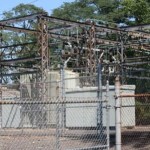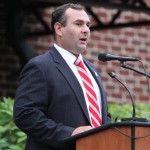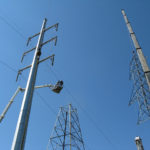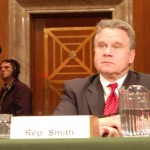Congressman Smith to NJ Transist: Don’t allow JCP&L power lines
NEWARK, N.J.—Rep. Chris Smith (NJ-04) testified today before the New Jersey Transit Corporation Board of Directors in an effort to convince the agency to reject the Jersey Central Power & Light Co (JCP&L) application to utilize the transit agency’s right-of-way for the proposed “Monmouth County Reliability Project.” JCP&L has proposed the 10-mile-long transmission line be placed through residential neighborhoods along NJT’s North Jersey Coast line, creating an undue burden for large numbers of people in five Monmouth County municipalities.
“Some may argue that there is little or no adverse health link to exposure to the electromagnetic fields created by these high-voltage lines, and may produce select studies that suggest that,” said Smith, Chairman of the U.S. House of Representatives’ Subcommittee on global health in his expert testimony. “But there is statistically relevant evidence–including studies–that suggest otherwise.”
Smith cited statistics from one of the several studies: “A massive French study that included all 2,779 cases of childhood acute leukemia in France over 2002-2007 and 30,000 contemporaneous population controls concluded that there were increased odds for childhood acute leukemia occurrence living within 50 meters of high voltage power lines.”
“Over my 36 years as a member of congress, I’ve been the prime author of several major Public Laws including research and services for persons with autism, assisting veterans with the Persian Gulf mystery illness, and a major amendment to help atomic veterans and their surviving widows and children,” Smith continued. “Each of those legislative initiatives had or has one thing in common—overcoming a culture of denial of the science.” Click Here to read Smith’s full testimony.
Smith explains that the so-called Monmouth County Reliability Project would create an unnecessary, lifestyle-shattering and dangerous 230-kilovolt transmission line near homes, parks, schools and places of worship in Aberdeen, Hazlet, Holmdel, Middletown and Red Bank. Reports have indicated that the transmission lines, which could be built on poles as tall as 210 feet at some points, would emit powerful electromagnetic fields (EMFs). Findings do not prove but indicate that EMFs may create an increased rate of cancer, including childhood leukemia, with the World Health Organization classifying it as “possibly carcinogenic,” and indicating that it is “sufficiently strong enough” to cause a concern.
“If NJ Transit accepts JCP&L’s proposal, home values will decline significantly, causing serious economic hardship for communities that are still reeling from Superstorm Sandy,” said Smith. “Testimony at a 2012 congressional hearing found that in Chino Hills California, property values plummeted overnight by 17%–or more–when a project nearly identical to JCP&L’s became a reality. Anyone who desires to sell or must sell due to a myriad of factors–including change of job or retirement–may not only suffer a steep loss but may have difficulty even finding a buyer.”
Smith has been helping to lead the charge to stop these harmful lines since June of this year. Over the summer, Smith walked the proposed route and met with those who lived there, including a citizen’s advocacy group dedicated to stopping the line known as RAGE (Residents Against Giant Electric), to hear firsthand how the powerline would disrupt their lives, safety and property. He believes that, given the possible health risks and strong opposition of the community, an abundance of caution must be exercised before any similar plan is put into place.












Thank you Congressman Smith. I too am very concerned about the significant impact of this project and urge NJ transit to reject JCP&L’s request that is not in the best interest of their customers and the community as a whole.
The science does not support the Congressman’s statement nor does the study he cites say that.
Recent studies (August 2012 to November 2014)Three
large case-control studies from France, Denmark, and the United Kingdom have assessed the riskof childhood leukemia in relation to residential proximity to high-voltage power lines (SermageFaure
et al., 2013; Bunch et al., 2014; Pedersen et al., 2014). The French study used geocoded
information on residential addresses and power line locations to examine the risk of childhood leukemia in association with distance to power lines between 2002 and 2007. Overall, the study included 2,779 cases of childhood leukemia and 30,000 control children (Sermage-Faure et al.,2013) and reported no statistically significant increase in leukemia risk with distance to power lines. The authors, however, noted a statistically non-significant risk increase in a sub-analysiswithin 50 meters of 225-400 kV lines, but this was based on a small number of cases (n=9). A similar study from Denmark included 1,698 cases of childhood leukemia and 3,396 healthy control children (Pedersen et al., 2014). The authors reported no risk increases for childhood leukemia with residential distance to power lines.
You have to be able to read to understand what Rep. Smith said. It would be impossible to reside within 50 meters of the powerlines since the poles suspending them are derided for being 200 feet high. No residence could be located close enough to the railroad right of way to be impacted even if you believe the science. This of course omits the obvious issue that buying residential property abutting a railroad tracks already comes with a risk of loss of value. Let’s just stay with the power outages every time a thunderstorm hits. Right.